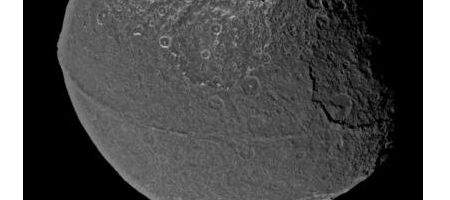In the five years since Cassini released images of a bizarre ridge encircling the equator of Saturn’s moon Iapetus, astronomers have struggled for an explanation.

But now a team has proposed that the ridge – some 12 miles high and 62 miles wide – was caused by a massive impact. They suggest that at one time Iapetus itself had a moon, created by a giant impact with another big body. But the moon’s orbit, they say, would have decayed because of tidal interactions with Iapetus.
At some point, the tidal forces would have torn the sub-satellite apart, forming a ring of debris that would eventually slam into the moon near its equator.
“Imagine all of these particles coming down horizontally across the equatorial surface at about 400 meters per second, the speed of a rifle bullet, one after the other, like frozen baseballs,” says William B McKinnon of Washington University.
“Particles would impact one by one, over and over again on the equatorial line. At first the debris would have made holes to form a groove that eventually filled up.”
The team says they have a lot of corroborating calculations that demonstrate that this is a plausible idea, and now plan rigorous simulations to show the process in action.
“Some people have proposed that the ridge might have been caused by a string of volcanic eruptions, or maybe it’s a set of faults,” McKinnon notes. “But to align it all perfectly like that — there is just no similar example in the solar system to point to such a thing.”
Andrew Dombard of the University of Illinois says that Iapetus’s Hill sphere — the zone close to an astronomical body where the body’s gravity dominates satellites — is far bigger than that of any other major satellite in the outer solar system, explaining why Iapetus is the only body known to have such a ridge.
“Only Iapetus could have had the orbital space for the sub-satellite to then evolve and come down toward its surface and break up and supply the ridge,” he says.






